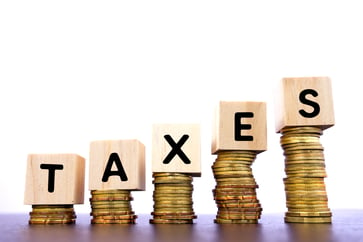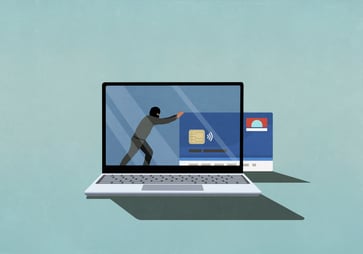My strategy for eliminating $8,000 of debt in six months.

In the spring of 2024, my dreams of financing a bathroom refresh in my home with a 0% APR card were shattered when our central air conditioning malfunctioned. Instead, I had to put $8,000 on the card to make it through the muggy summer.
Instead of using my 0% APR card responsibly and sticking to a payment schedule, I felt overwhelmed that we'd spent money on a necessity instead of a bathroom upgrade and ignored the balance, making only the minimum payment. By October 2024, I had six months left on the zero-interest intro period and owed $8,200. If I don't pay the balance before the regular rate kicks in, my soon-to-be husband and I would get a pile of high-interest debt as a wedding present.
I am paying off more than $8,000 of debt in six months.
The card that helped me tackle a big bill
The Chase Freedom Unlimited® card allowed me to finance a large expense with a 0% APR, which was valid for 15 months from account opening on new purchases (later changing to a variable APR of 19.99% - 28.74%).
It made the most sense for me, as a Chase account holder with other cards from the issuer, to open the Freedom Unlimited card because I had already accumulated a significant amount of Ultimate Rewards® Points through my other Chase cards, and our upcoming large expenses would further increase my rewards points balance.
If I wasn't already a Chase user, I might have chosen the Wells Fargo Reflect® Card because it offered a longer 21-month introductory 0% APR on purchases and qualifying balance transfers (with 17.74%, 24.24%, or 29.49% variable APR after; balance transfers made within 120 days from account opening qualify for the introductory rate). However, because I was familiar with Chase's rewards system and didn't think I needed a longer 0% APR period, I opted for the Freedom Unlimited instead.
My step-by-step plan to dig out of debt
With my fiance, I created a financial plan for the next six months to pay off the debt on time.
1. Start with a solid budget
To make informed decisions about getting out of debt, I needed to know where our money was going. Therefore, creating an emergency budget was the initial step.
We need to allocate $1,300 monthly towards the card balance to cover the remaining six months of the intro period. While challenging, it is achievable.
I utilized a budgeting app that links to both my and my fiance's financial accounts to monitor our monthly inflow and outflow.
I prefer visual aids, and I found Empower helpful in tracking and visualizing our net worth through a personal dashboard. The tool also creates budgets and charts debt balances to show changes over time. I also like the phone app for quick checks.
If Empower doesn't suit your needs, there are numerous alternatives available. For instance, Monarch was included in our list of top budgeting apps due to its user-friendly interface.
I created a zero-based budget using that dashboard, which means every dollar is allocated to an expense or debt payoff. This leaves little room for other spending, so my fiance and I have drastically cut back. However, there are a few exceptions, such as caring for our 16-year-old cat, Fudge, and making wedding deposits. Overall, we're not spending much at all.
We're considering removing some items to reduce expenses.
- I enjoy leaving my home occasionally, but I estimate that I spend around $75 to $100 monthly at coffee shops. To save money, I plan to replace these trips with visits to my local library. Additionally, we often opt for takeout when life is busy, but I am now cooking more and storing leftovers in the freezer for easy meals. This change should allow me to save approximately $240 per month towards debt repayment.
- By being intentional with meal prepping and bulk buying, we can reduce our monthly grocery spending by approximately $200.
- We enjoy spending time with friends, but we prefer to do it at home or on a budget whenever possible. Instead of going out for a birthday celebration, we opted to host a gathering at our place. I estimate that this saved us approximately $100 compared to going out, and we do this once a month.
- We estimate that we spend about $300 a month on non-essential items, such as occasional trips to a nail salon and spontaneous online purchases.
To increase our revenue, we plan to sell some clothes and camera equipment we no longer require.
2. Using the right cards for smart spending
To avoid derailing our long-term goals, I am more mindful about how to pay for certain expenses, rather than just making big cuts to our spending.
A regular contribution to my Fidelity Roth IRA is a non-negotiable line item on the budget. I aim to contribute as close to the limit as possible each year, which is $7,000 per year or $8,000 per year if you're age 50 or older. This amounts to approximately $134 per week out of the budget that cannot be spent on groceries and other essentials.
By utilizing the Fidelity® Rewards Visa Signature® Card, I can earn 2% cash back on all eligible spending when redeeming the rewards as a direct deposit into a Fidelity IRA, HSA or 529 plan. This means that every time I use the card for expenses I can't avoid, 2% of the costs will go towards my retirement account.
3. Re-evaluate every expense
Recurring subscriptions can easily slip through the cracks and drain finances, as I have learned from previous budgets.
Tracking card information across multiple accounts can be tedious, but Chase's Saved Account Manager streamlines the process. Accessible through the Chase mobile app, it displays all saved accounts linked to your card and highlights those with recurring charges.
I re-evaluated recurring services and subscriptions as an Account Manager and decided to cancel a few that we could do without, resulting in a monthly savings of $30 or $180 over six months.
4. Negotiate down essential expenses
I have identified two expenses on my budget that I can target for better pricing: car insurance and my internet bill.
One way to reduce our $2,300 annual auto insurance cost for a full-coverage policy with two drivers and two cars is to bundle it with our condo insurance.
Two insurance providers I am considering are Amica and Geico, both reputable for providing affordable and reliable coverage. Amica offers a bundling discount of up to 30%, while Geico provides a discount for combining car and condo insurance.
I'm receiving three to four quotes from insurers for our condo coverage to determine if we can lower the price in the future. If we do, I will switch insurance policies.
Some services, such as Trim and RocketMoney, can negotiate your bills for you and lower the amount you pay, helping you save on utilities like internet and cable.
I plan to negotiate our internet bill by calling the company and using my good payment history to my advantage. If I am successful, I will put the savings towards our debt payoff, with $20 off per month equating to $100 over six months.
Why trust CNBC Select?
Our mission at CNBC Select is to deliver top-notch service journalism and in-depth consumer advice to our readers, enabling them to make well-informed decisions when it comes to managing their finances. Each debt payoff review we publish is the result of thorough reporting by our team of expert writers and editors, who possess extensive knowledge of personal finance products. At CNBC Select, we maintain the highest journalistic standards and ethics, and we earn a commission from affiliate partners on many offers and links. However, our content is created independently, without any input from our commercial team or external third parties. To learn more about our methodology and how we select the best debt payoff products, please refer to our detailed explanation.
Stay up to date with CNBC Select's comprehensive coverage of credit cards, banking, and money by following us on TikTok, Facebook, Instagram, and Twitter.
Select
You might also like
- An accessible credit card that earns rewards: A review of the Firstcard Secured Credit Builder Card with Cashback.
- In 2027, American Express will launch a Centurion Lounge at Boston Logan Airport.
- Are online banks less safe than traditional banks?
- Navy Federal Credit Union mortgage review 2025: A comprehensive analysis of their mortgage products and services.
- Review of pet insurance in 2025



















